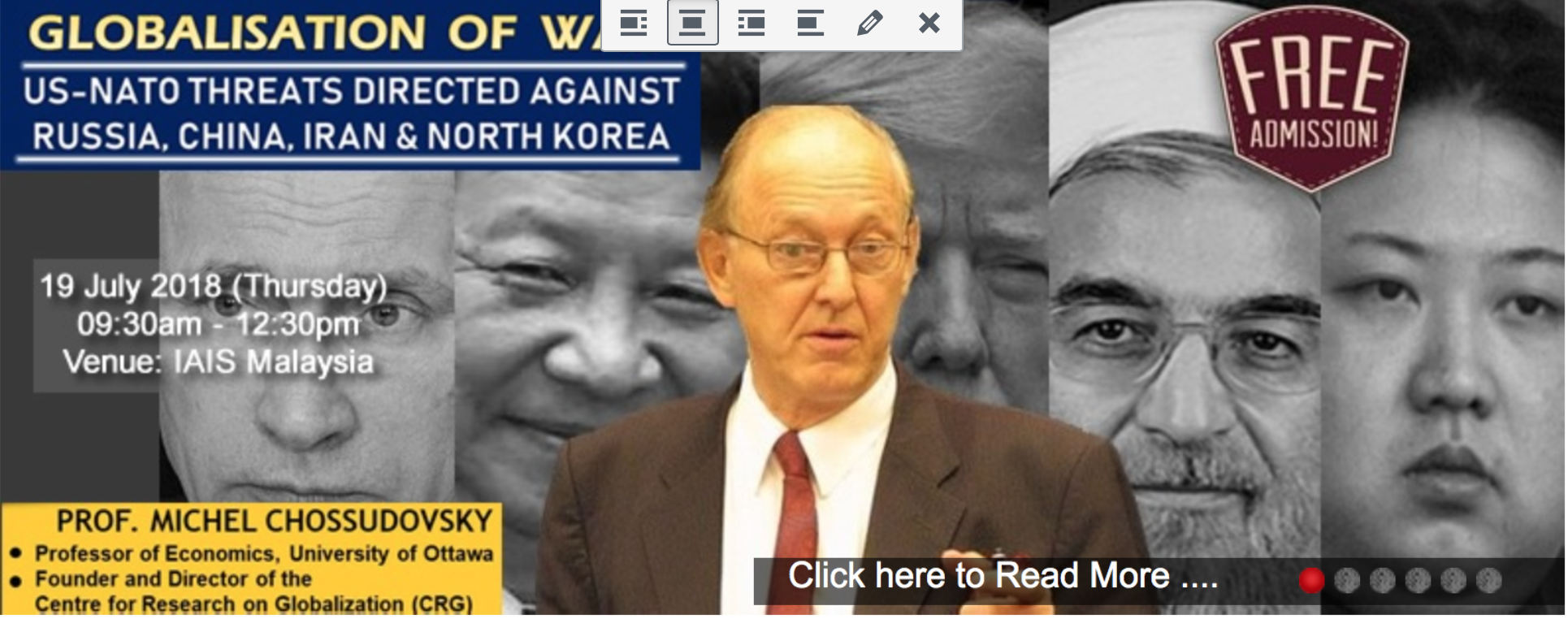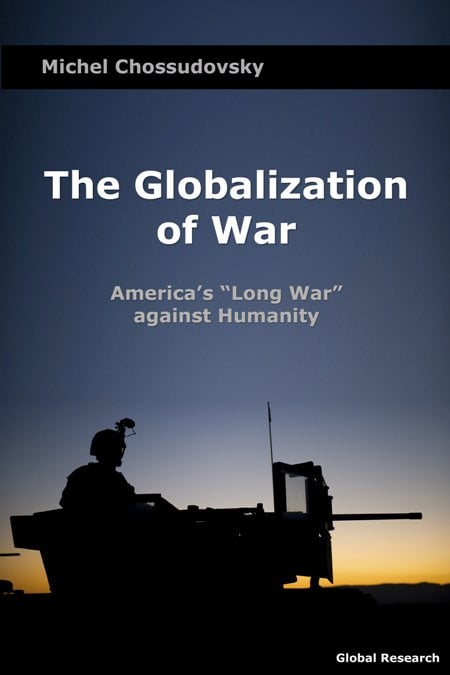Imperial Conquest: America’s “Long War” against Humanity

His diplomacy is founded in the concept that those who are to lead the world must do so on the basis of values and attitudes that are shared by the majority of the world’s population.1
• fight and decisively win multiple, simultaneous major theater wars;
• perform the “constabulary” duties associated with shaping the security environment in critical regions;
• transform U.S. forces to exploit the “revolution in military affairs;”4
“As I went back through the Pentagon in November 2001, one of the senior military staff officers had time for a chat. Yes, we were still on track for going against Iraq, he said. But there was more. This was being discussed as part of a five-year campaign plan, he said, and there were a total of seven countries, beginning with Iraq, then Syria, Lebanon, Libya, Iran, Somalia and Sudan.6
We have discovered the most terrible bomb in the history of the world. … This weapon is to be used against Japan … [We] will use it so that military objectives and soldiers and sailors are the target and not women and children. Even if the Japs are savages, ruthless, merciless and fanatic, we as the leader of the world for the common welfare cannot drop that terrible bomb on the old capital or the new. … The target will be a purely military one…It seems to be the most terrible thing ever discovered, but it can be made the most useful.7The World will note that the first atomic bomb was dropped on Hiroshima a military base. That was because we wished in this first attack to avoid, insofar as possible, the killing of civilians..8
possesses 5,113 nuclear warheads, including tactical, strategic, and non-deployed weapons.9
the U.S. deploys 1,654 strategic nuclear warheads on 792 deployed ICBMs, SLBMs, and strategic bombers…
The avowed objective of these military interventions has been to effect ‘regime change’. The cloaks of “human rights” and of “democracy” were invariably evoked to justify what were unilateral and illegal acts.”10
Furthermore, we have about 50% of the world’s wealth but only 6.3% of its popu- lation. This disparity is particularly great as between ourselves and the peoples of Asia. In this situation, we cannot fail to be the object of envy and resentment. Our real task in the coming period is to devise a pattern of relationships which will permit us to maintain this position of disparity without positive detriment to our national se- curity. To do so, we will have to dispense with all sentimentality and day-dreaming; and our attention will have to be concentrated everywhere on our immediate national objectives. We need not deceive ourselves that we can afford today the luxury of al- truism and world-benefaction.…In the face of this situation we would be better off to dispense now with a number of the concepts which have underlined our thinking with regard to the Far East. We should dispense with the aspiration to “be liked” or to be regarded as the repository of a high-minded international altruism. We should stop putting ourselves in the position of being our brothers’ keeper and refrain from offering moral and ideological advice. We should cease to talk about vague and–for the Far East–unreal objectives such as human rights, the raising of the living standards, and democratization. The day is not far off when we are going to have to deal in straight power concepts. The less we are then hampered by idealistic slogans, the better.11
[I. F. Stone’s book] raised questions about the origin of the Korean War, made a case that the United States government manipulated the United Nations, and gave evidence that the U.S. military and South Korean oligarchy dragged out the war by sabotaging the peace talks,14
I. F. Stone’s analysis refutes “the standard telling” … that the Korean War was an unprovoked aggression by the North Koreans beginning on June 25, 1950, under- taken at the behest of The Soviet Union to extend the Soviet sphere of influence to the whole of Korea, completely surprising the South Koreans, the U.S., and the U.N.”But was it a surprise? Could an attack by 70,000 men using at least 70 tanks launched simultaneously at four different points have been a surprise?Stone gathers contemporary reports from South Korean, U.S. and U.N. sources docu- menting what was known before June 25. The head of the U.S. CIA, Rear Admiral Roscoe H. Hillenloetter, is reported to have said on the record, “that American intelli- gence was aware that ‘conditions existed in Korea that could have meant an invasion this week or next.” (p. 2) Stone writes that “America’s leading military commentator, Hanson Baldwin of the New York Times, a trusted confidant of the Pentagon, reported that they [U.S. military documents] showed ‘a marked buildup by the North Korean People’s Army along the 38th Parallel beginning in the early days of June.’ ”15 (p. 4) How and why did U.S. President Truman so quickly decide by June 27 to commit the U.S. military to battle in South Korea? Stone makes a strong case that there were those in the U.S. government and military who saw a war in Korea and the resulting instability in East Asia as in the U.S. national interest.16
If Stone’s thesis corresponds to reality, we are in the presence of the greatest swindle in the whole of military history… not a question of a harmless fraud but of a terrible maneuver in which deception is being consciously utilized to block peace at a time when it is possible.16
We have come to the conclusion that [South Korean president] Syngman Rhee delib- erately provoked the North Koreans in the hope that they would retaliate by crossing the parallel in force. The northerners fell neatly into the trap.17
It is now believed that the population north of the imposed thirty-eighth Parallel lost nearly a third its population of eight to nine million people during the thirty-seven-month-long “hot” war, 1950-53, perhaps an unprecedented percentage of mortality suffered by one nation due to the belligerence of another.21
we’ve got to expect a fair amount of repression, probably a good deal of blood, in Argentina before too long.22
2. “Through focused, sustained engagement with partners in support of our shared security objectives”. AFRICOM’s area of jurisdiction extends to the entire “African continent, its island nations, and surrounding wa- ters”.
3. Project for A New American Century (PNAC), Rebuilding America`s Defenses, Strategy, Forces and Re- sources for a New Century, Washington D.C. 2000.
4. Ibid.
5. See Chris Floyd, Bush’s Crusade for Empire, Global Outlook, No. 6, November, 2003.
6. See Secret 2001 Pentagon Plan to Attack Lebanon, Global Research, July 23, 2006.
7. President Harry S. Truman, Diary, July 25, 1945.
8. President Harry S. Truman in a radio speech to the Nation, August 9, 1945.
9. ArmsControl.org, April 2013.
10. Eric Waddell, The United States’ Global Military Crusade (1945-2003), Global Research, 2003.
11. George F. Kennan, 1948 State Department Brief, emphasis added.
12. Ibid.
13. Martin Hart-Landsberg, Korea: Division, Reunification, & U.S. Foreign Policy. Monthly Review Press. New York, 1998 pp. 65–6). The PRK was abolished by military decree in September 1945 by the U.S.AMG.
14. Jay Hauben, Book Review of I.F. Stone’s Hidden History of the Korean War, OmnyNews, 2007. http://www.globalresearch.ca/the-hidden-history-of-the-korean-war/5342685.
15. Ibid.
16. Quoted in Stephen Lendman, “America’s War on North Korea”, Global Research, April 1, 2013, http://www.globalresearch.ca/americas-war-on-north-korea/5329374.
17. Ibid.
18. Bruce Cumings, Korea: Forgotten Nuclear Threats, 2005.
19. Ibid.
20. Quoted in Brian Willson, Korea and the Axis of Evil, Global Research, October 2006.
21. Ibid.
22. Argentina, Declassified documents, Kissinger sought immediate support for the new military regime in spite of staff warnings on bloodshed, National Security Archive, March 23, 2006.
23. NATO Communiqué, September 12, 2001 quoted in Michel Chossudovsky, September 11, 2001: The Crimes of War Committed “In the Name of 9/11′′, Global Research, http://www.globalresearch.ca/september- 11-2001-the-crimes-of-war-committed-in-the-name-of-911/5311561, Perdana Global Peace Foundation, No- vember 2012. emphasis added.
24. Defense Threat Reduction Agency and U.S. Strategic Command (U.S.TRATCOM) , http://www.dtra.mil/about/WhoWeAre.aspx.
25. Ibid.
26. Michel Chossudovsky, Nuclear War against Iran, Global Research, January 3, 2006.
29. Mahdi Darius Nazemroaya, Global Military Alliance: Encircling Russia and China, Global Research, October 5, 2007.







/https://www.niagarafallsreview.ca/content/dam/thestar/news/canada/2021/09/25/huawei-executive-meng-wanzhou-receives-warm-welcome-upon-return-to-china/_1_meng_wanzhou_2.jpg)













No comments:
Post a Comment
Note: Only a member of this blog may post a comment.